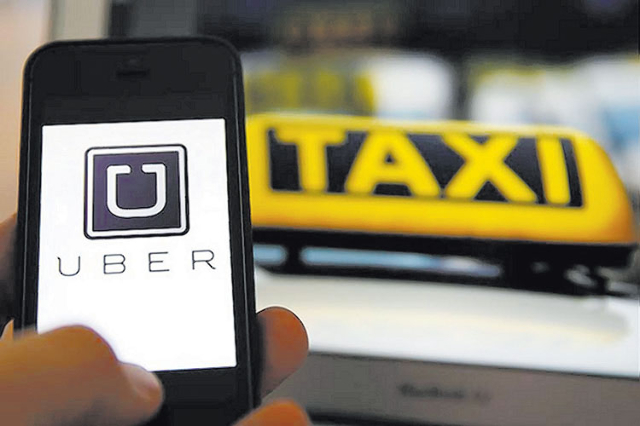Laying down rules for Uber, Lyft isn’t a simple process

If you‘re a fan of Uber and Lyft, you‘re one step closer to ride-hailing nirvana.
But if you‘re a critic, you‘re one step closer to ride-hailing Armageddon.
I have received dozens of emails from Warrior readers asking about the latest on the legalization of transportation network companies. Last week and this week, the process is moving forward.
For those who haven‘t been keeping up, the Legislature in May passed legislation legalizing such companies and left it in the hands of the Nevada Transportation Authority to deal with the details of writing the rules and regulations by which they will operate.
It wasn‘t an easy task because everybody has a preconceived notion of what Uber and Lyft are, and lawmakers directed the Transportation Authority to draft a whole new set of rules and not rely on statutes that have existed for years for taxis and limousines, though they will operate much like them. Under the rule making process, the authority delivered a first draft with 150 sections and then asked the public for comment
The task of producing that first draft fell on the shoulders of James Allen Day, a good-humored administrative attorney who admitted that he borrowed liberally from other statutes to put together something he felt the Legislature was looking for.
In the first of two workshop meetings, the public was invited to poke holes in Day‘s work.
And it did. Vigorously.
Through the 5½ hours the authority board and staff met, presiding officer Keith Sakelhide guided the review section by section.
The process went something like this:
Uber suits commented on a regulation. Taxi and limousine company representatives responded with their views. Lyft suits commented on the regulation. Taxi and limousine company representatives responded with their views. A random member of the public, maybe a cabdriver, maybe an advocacy group chimed in. Taxi and limousine company representatives proposed an idea. Uber and Lyft suits rejected it.
Sometimes, the Uber and Lyft suits would opine that a regulation wasn‘t necessary or that it didn‘t conform to the intent of the Legislature.
You can see why the authority didn‘t make it through half the proposed regulations in the first hearing.
Probably the most interesting disclosure was Uber‘s and Lyft‘s assertion that getting licensed in Nevada would cost them more than any other place they‘ve entered a market.
The authority conducted a financial analysis and determined that an unlimited number of cars and drivers coming into the market required a $500,000 cost of admission. That doesn‘tount the $50-per-driver fee that has been proposed. (We don‘t know yet whether the companies will bear the cost or whether they will ask their contracted drivers to do so.)
Don’t worry about whether the half-million will scare either company away. They will be able to recoup that in a good Vegas weekend, and both are invested to get into the local market.
They did, however, tell the authority that they will look into ways to take care of some regulatory and administrative tasks themselves so that the state doesn’t have to charge as much.
Call me skeptical, but I don’t find much comfort in hearing that a regulated company is volunteering to do regulatory things itself.
One of the reasons the authority is charging so much is that it’s going to have to hire more enforcement staff, not just to oversee the companies, but to keep on the lookout for drivers posing as Uber and Lyft drivers working off the app. It‘s totally illegal, but the regulators believe it’s going to happen.
Another highlight: A proposed regulation would require a permitted driver to attach signage "in letters not less than 2 inches high in sharply contrasting colors which are legible from a distance of at least 50 feet" identifying the vehicle as that of an Uber or Lyft driver. Remember, these are people‘s personal vehicles.
The Uber and Lyft suits said the drivers would never go for it. They suggested allowing a magnetic sign to suffice. But the regulators said it would defeat the purpose of identifying a vehicle because a magnetic sign could easily be transferred to another car and the purpose is to identify a car that has been inspected by the regulators.
Both sides said they would work on it and bring it back for discussion.
What Thursday‘s meeting did was affirm that the ride-hailing service the public has been clamoring for will be in operation soon.
If you‘re a resident of Las Vegas who needs a ride occasionally, the service is convenient and will be helpful. If you want to drive part time, you will be able to set your own hours – but don‘t count on getting rich. It‘s not really a good model for an individual to make a ton of cash unless you’re really good at it — which most of us aren‘t.
The authority will plow forward in the review of the rest of the regulations, and the plan is to ask the public to offer its own suggestions. A copy of the proposed regulations is available at the authority‘s website, nta.nv.gov.
Another round of comments is scheduled 9 a.m. Thursday in Room 4412 of the Sawyer Building.
Persons who want to email their own regulatory suggestions can send them to jday@nta.nv.gov.
Questions and comments should be sent to roadwarrior@reviewjournal.com. Please include your phone number. Follow @RJroadwarrior on Twitter.












